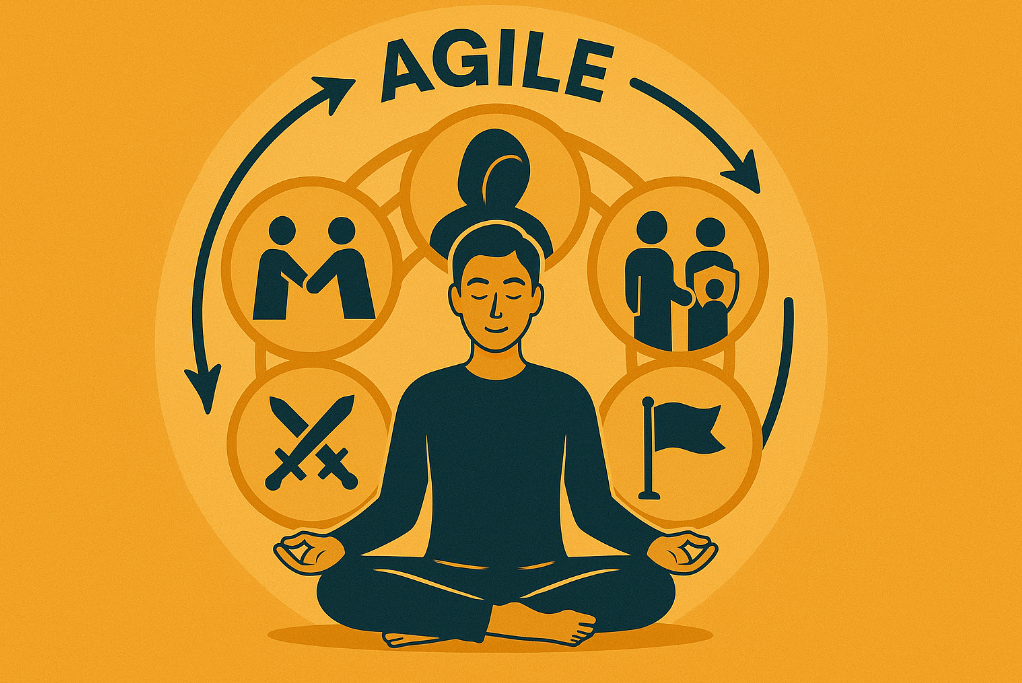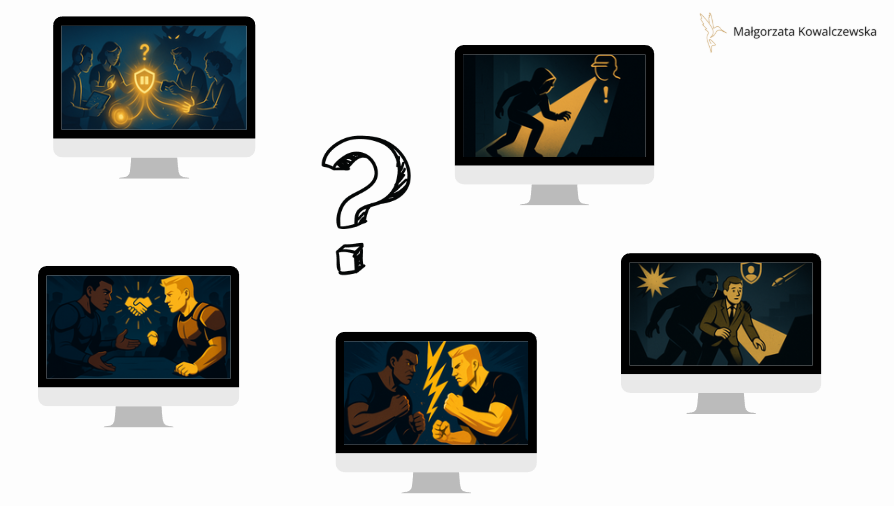
Until recently, I was convinced that cooperation is the best way to resolve conflicts. Always. Without exception. This belief has accompanied me for years, reinforced by books, trainings and work methodologies or frameworks. Especially in a work environment based on Agile, where cooperation is a paramount value and is inflected in all cases. No wonder – after all, cooperation gives the best results.
However, my approach has completely changed, and all thanks to… computer games.
In games, we have different modes – we can play solo or with others, we can choose between adventure and survival mode, between strategy and action. What’s more, our choice often depends on many factors: available time, mood, company, or even the goal we want to achieve.
The more I talk to leaders, the more I see the diversity of behaviors in the cases they describe. Everyone has some habits and beliefs. Accustomed to the fact that a given strategy usually works, we apply it in every situation. Meanwhile, this is not what agility is about.
Why do we stick to one mode?
In my research on resolving conflicts at work, conducted on a group of over 100 people, most respondents indicated cooperation as the most common reaction to approaching a conflict. At the same time, the same people admitted that conflicts mainly cause them to feel frustrated, angry and in a bad mood.
A paradox? Not really. The problem is that we stick to one mode of resolving conflicts, even though it does not always fit the situation, or we do not have the necessary skills to use it. It is like trying to play the entire game using only one weapon or one strategy.
Agile Mode – Mastering the art of changing modes
And here we come to the concept I have called “Agile Mode” – a mode in which we accept the reality of VUCA (variability, uncertainty, complexity, ambiguity) and treat conflicts not as obstacles, but as natural elements of the game. A mode in which we know and can use different options and strategies.
Leadership in this context is not about eliminating conflicts, but about skillfully navigating through them – about consciously choosing when to take an active part, when to mediate, and when to make difficult decisions.
Below, I would like to introduce the individual modes of the conflict game, the possibilities of their application, tips to extend the use of different modes for those who prefer a particular one, as well as advantages of Agile Mode of conflict resolution.

1. Co-op Campaign (Collaborating Mode)
Characteristics: Players cooperate to achieve a goal together, find a solution, overcome all challenges. It requires time and commitment, but leads to lasting, high-quality solutions.
When it works:
- For important, complex problems that require innovative solutions
- When relationships are as important as the solution itself
- When the parties have time to thoroughly solve the problem
- When we want all parties to be fully engaged
When used in inappropriate circumstances:
- Wasting time and energy on problems that can be solved faster
- Slowing down the response to crisis situations that require immediate action
- People’s expectations that every element of the process, product, strategy will be consulted with them
- Causes frustration due to unfulfilled promises
Tips for opening up for those who prefer this style:
- Conflict severity assessment – Make a list of 2-3 questions that will help you decide whether cooperation makes sense
- Timeboxing technique – Establishing strict time limits for the cooperation process
- 3-step method for small conflicts – Simplified procedure for less complex situations: 1. Name the problem 2. Listen quickly 3. Choose a simple and quick solution
- Quick decision practice – Practice faster, less cooperative solutions every day
2. Stealth Mode (Avoiding)
Characteristics: The player’s task is to act in a way that is invisible to enemies, avoiding confrontation, and eliminating threats without direct combat. The idea is to navigate around conflict without direct confrontation. It can be a strategic choice when change is not possible, the problem is trivial, or when time to cool down is needed. The risk is leaving conflicts unresolved.
When it works:
- When the problem is trivial or temporary
- When emotions are too strong and time to cool down is needed
- When there is no chance of any change
- In situations where the benefits of confrontation are minimal compared to the costs
When used in inappropriate circumstances:
- Leaves conflicts unresolved
- Can lead to mounting frustration and resentment
- Often interpreted as disengagement or passivity
- Can lead to loss of respect and influence
Tips for those who prefer this style:
- Fear vs. strategy – Practice writing down reasons for avoidance and analyzing them
- Practice of micro-courage – Systematic undertaking of small conflicts with increasing difficulty (feel the fear and do it anyway)
- Delayed response technique – Postponing the decision for a specific time, instead of avoiding
- Bridge messages – Previously prepared, ready phrases to use – instead of total avoidance
3. Escort Mission (Accomodating)
Characteristics: The main goal is to provide protection for a given character and keep them alive during one or more challenges without killing them or taking serious damage. In other words, in a conflict, you make sure that the other side gets what they need. Characterized by high concern for relationships and low concern for one’s own needs.
When it works:
- When preserving the relationship is most important
- When the issue is more important to the other party
- In situations where a concession here and now can bring benefits in the future
- When we need to build “goodwill capital”
When used in the wrong circumstances:
- Can lead to suppression of one’s own needs and frustration
- Often results in suboptimal solutions
- Can be perceived as weakness or lack of one’s own opinion
- In the long run, can lead to burnout and resentment
Tips for those who prefer this style:
- Needs journal – Practice writing down one’s own neglected needs
- 1-10 value test – Reflective technique of assessing the importance of issues after the fact, taking into account the criteria of “relationships” and “needs (mine/team)” on a scale of 1-10
- Practice of small “no”s – Systematic practice of saying no to small matters
- Monitoring reciprocity – Keeping a record of the “balance of concessions” in relationships
4. Battle Royale (Competitive Mode)
Characteristics: The goal is individual victory – players use their resources, ranks, strength. Characterized by high concern for one’s own interests and low concern for the relationships or needs of others.
When it works:
- In crisis situations requiring a quick, decisive response
- When unpopular but necessary decisions need to be implemented
- In defense against exploitation or manipulation
- When fundamental values or principles are at stake
When used in the wrong circumstances:
- Often leads to conflict escalation
- Destroys relationships and trust
- Discourages future cooperation
- May lead to suboptimal solutions by not considering all perspectives
Tips for those who prefer this style:
- Consequence Test – Asking about the impact on long-term relationships, e.g., “Is winning this argument worth the potential cooling of the relationship?”
- PREP Technique – A structured method of persuasive communication: P (point) – presenting the main thesis, R (reason) – justifying the position, E (example) – a specific example illustrating the argument, P (point) – returning to the main thesis. Facilitates a substantive exchange of arguments instead of forcing your will.
- 5-breath rule – A practical technique for controlling impulsive reactions. It consists of taking five deep breaths before responding to a conflict situation.
- The Alternatives Method – Preparing several variants of solutions before confrontation
5. Diplomacy Mode (Compromise Mode)
Characteristics: Players start from a similar strength’s level, representing different factions with their own goals and resources. Each wants to gain as much as possible for themselves, but must also form alliances and negotiate concessions so as not to be completely eliminated. Success requires negotiation skills, seeing common interests, and a willingness to give up some resources or influence in exchange for concessions from other players.
When it works:
- When time is limited and a quick solution is needed
- When full cooperation is not possible due to external constraints
- When the parties have comparable power and cannot impose a solution
- As a temporary solution to complex problems
When used in the wrong circumstances:
- Often leads to suboptimal solutions
- May leave all parties feeling unsatisfied
- Focuses on strategies rather than deeper needs
- Can be perceived as “taking the easy way out”
Tips for those who prefer this style:
- Long-term impact analysis – Specific questions about the durability of the compromise
- Depth technique – Create a list of questions that help identify the root causes of the problem
- Delayed compromise practice – Deliberately delaying a decision to find a better solution (e.g. by 24 hours). Often leads to the discovery of better solutions than those that were visible under the pressure of an immediate decision.
- 3-Dimensional Fairness Test – A system that evaluates a compromise on three key dimensions: procedural (whether the process of reaching a solution was fair), distributive (whether the benefits and burdens are distributed appropriately), and relational (whether the solution strengthens or weakens the relationship).
Agile Mode: Flexible conflict management
Agile Mode is a meta-style characterized by a conscious choice of one of the above modes of approaching conflict, depending on the context. People operating in this mode:
- Accept the reality of VUCA (volatility, uncertainty, complexity, ambiguity)
- Treat conflicts as natural elements of social interactions
- Flexibly select a conflict management style to the specifics of the situation
- Are able to switch between different approaches depending on needs
Key Agile Mode skills:
- Situational awareness – the ability to quickly assess the context of conflict
- Self-awareness – understanding your own preferences and limitations
- Flexibility – the ability to switch between different styles
- Mental resilience – the ability to maintain balance in the face of tensions
- Strategic thinking – the ability to choose the best approach to achieve long-term goals
Tips for practicing and developing the ability to use Agile Mode:
- Conflict style journal – Systematically write down and analyze your own reactions to conflict situations (mode, context, effect). Regularly reviewing your notes will help you identify habitual patterns and situations that trigger certain styles, allowing you to make more informed choices in the future.
- Practice the Reverse Mode – Deliberately practice a conflict resolution style that is the opposite of your natural dominant style for a month. For example, a person who normally avoids confrontation will consciously take assertive (do not confuse with aggressive) action in small matters. This technique develops flexibility and broadens your repertoire of behaviors, allowing you to move beyond your established patterns.
- Peer Feedback– Regularly ask for feedback from trusted people about your conflict resolution style. This will provide you with an outside perspective on your own behaviors that you may not be aware of.
Choose Your Mode Consciously
Leadership in this context is the ability to play in different modes – despite discomfort. After all, to “taste” a different mode, you have to try it, you have to learn how to play it. Similarly, in conflict – it’s not about treating every dispute the same, but about navigating it skillfully depending on the context, time, and resources. Agile Mode allows you to consciously choose when to take an active part in a conflict, when to mediate, and when to make firm decisions.
So think about what your favorite modes of dealing with conflict are? Are you able to change them when the situation requires it? Or maybe — like many of us — do you cling to one approach, hoping that this time it will work?
Remember that just like in games, in conflicts, you don’t become a master by mastering one technique, but by the ability to choose the right strategy at the right time.



